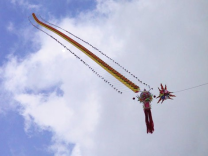
China is universally acknowledged as the birthplace of kites. Kites originated in the Spring and Autumn Period over 2,000 years ago. Legend has it that the wooden bird made by the ancient philosopher Mozi was the earliest kite. Later, his disciple Lu Ban made some improvement on the wooden kite by using bamboo as the material. The creation gradually evolved into current multi-line kites.
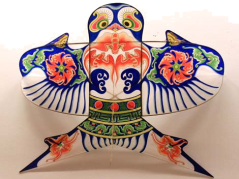
Folklorists hold that ancient people invented kites to be in memory of dead family members and friends. That’s why they would fly kites on the Qingming Festival, a day ancient people believed the gate of hell would throw open, to send their greetings to their loved ones who passed away via the kite. In the Tang and Song Dynasties, due to the booming of paper making industry, people began to make kites with paper. In the late Tang Dynasty, some people added musical strings to kites. When the wind blew, the kites gave out sounds like the guzheng (an ancient Chinese music instrument), hence the name of “Feng Zheng” (literally meaning “Zheng in the wind”). In the Song Dynasty, flying kites became a popular outdoor activity, with lots of poems and paintings portraying kite-flying scenes.
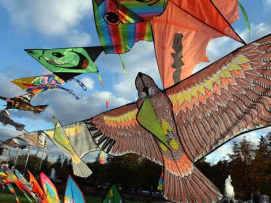
In ancient times, apart from being an entertainment article, a kite could also be used for military purposes, such as distance measuring, information transmitting and dangerous spot crossing etc. In 190 BC, when the war between Chu and Han was underway, the Han general Han Xin used a kite to measure the length of the tunnel under the Weiyang Palace when he launched an attack against the palace. And during the Battle of Gaixia, when Xiang Yu’s troops were surrounded by Liu Bang’s troops, Han Xin ordered the making of a cowhide kite, with a bamboo flute attached to it. When the kite was flown in the wind, the Han army sang some Chu songs with the flute, breaking up the Chu army’s morale. The Han army won the battle in the end. This was the origin of the Chinese idiom “Simian Chuge” (literally meaning “Chu songs all around”, it’s a phrase that means “under attack from all directions”).
Today, Weifang City of Shandong Province is widely regarded as “the world’s capital of kites”. The most famous kites of Weifang are Longting (Dragon Pavilion) and Julong (Giant Dragon) kites. In Kaifeng, there’s an age-old custom still popular today. On the Qingming Festival, people fly kites as high and far as possible and cut the line on purpose, allowing the kites to drift in the sky with the wind. This is a symbol of letting go the unhappiness and sadness accumulated in the previous year, which is believed to keep illnesses at bay during the whole year. In addition, a kite is a carrier of hope. If a fish is drawn on a swallow-shaped kite, it has a hidden meaning of “the wish of surplus every year”, because the word “fish” has the same pronunciation as that of “surplus” in Chinese. If bats, peaches, pine trees and cranes are painted on a kite, it means fortune, wealth and longevity.
1. According to the text who invented the first kite?2. What was the kite used for in ancient times?
3. Why would the ancient people fly kites on the Qingming Festival?
4. Explain the Chinese idiom “Simian Chuge” in English.
5. Why do people fly kites as high and far as possible and cut the line deliberately?
相似题推荐
【推荐1】In New York City, eating on the subway is controversial. No law bans the practice, but a Democratic state senator introduced one last week. The proposed law would ban eating on the subway system and fine first time violators $250, according to the New York Times. Supporters of the bill argue that eating on the subway attracts rates. Other say the broader target should be those who carelessly drop litter in public places, rather than those who carefully sip their coffee and eat their bread on the way to work. They also argue that “street food” is an important part of New York’s culture and history. Banning its consumption in public areas such as the subway would have negative effects.
Street food and eating in public places is along-established cultural practice in cities like New York, Beijing and Paris. But commonly, it has been traditionally thought of as what the lower classes would do. Eating in public was (and in some places, still is) associated with uncivilized, poorer people. In the 19th century, eating in public was seen as a threat to morality and public health. Putnam’s (a popular magazine at the time) stated, “Eating in public may lead to a certain freedom of manner in little ladies and gentlemen. It was something people in the Victorian era did not want to encourage. A recent New York Times article drew a link between this moral panic about street food and concern over the growing populations of Irish German, Italian and Jewish immigrants who ran food carts in the 1800s. “To Victorian society, immigrant street peddlers were called ‘hucksters’, a name that still has a bit of moral judgment to this day.”
In Australia, street food is not something you see every day. Carts selling tasty snacks only come out for festivals or market days. However, eating in public places such as parks is encouraged. Outdoor barbeques at the beach or picnics in the countryside are common. While eating on public transport is discourages, it would unlikely lead to any sort of conflict in Australia. From an Australian perspective, street food is an exciting and tasty new dining opportunity, and not one I would associate with being uncivilized.
China’s street food scene is similar to that of New York City’s: It is a culturally entrenched practice and one that adds a lot of color and flavor to the scene of streets. But whether you love eating street food, or have to eat your breakfast on the run, it’s best to be considerate when enjoying a bite in public.
1. Supporters of “street food” are against the bill, because ________.| A.eating on the subway may attract undesirable pests like mice |
| B.consuming food on the way to work proves their carefulness |
| C.banning litter-dropping is more important for the environment |
| D.enjoying a bite in public areas is a part of the city’s culture |
| A.Only the uncivilized, poorer people were allowed to eat in public places. |
| B.Street food was seen as a threat in the 19th century because they were not heathy. |
| C.Eating in public was considered impolite for children in the Victorian era. |
| D.Immigrant street peddlers were encouraged and thus welcomed in the 1800s. |
| A.Eating in public like parks may be seen as ill-mannered. |
| B.Having food on the subway system may cause serious conflicts. |
| C.People may feel excited about being allowed to eat in public. |
| D.Tasting street food may bring much enjoyment whenever possible. |
| A.deep-rooted | B.eye-catching | C.well-known | D.far-reaching |
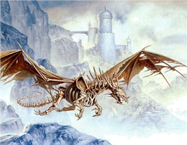
Dragon culture exists in both the Eastern world and the Western world. However, dragons have different reputation in western culture and in Chinese culture. The Western dragons are evil animals from hell. They usually have wings and can send out fire from their mouths.
▲Offspring of the Dragon
A dragon has an extending forehead indicating wisdom and antlers signifying longevity. Its ox’s ears stand for success in the imperial examination; it has tiger’s eyes as a sign of power; eagle’s claws showing bravery; while a fish’s tail implies flexibility and the horse’s teeth are a mark of diligence and so on.
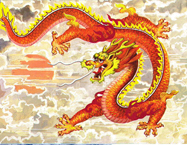
Dragons are deeply rooted in Chinese culture, so the Chinese often consider themselves as “the descendants of the dragon”. In Chinese culture, dragons are generous and wise. They are closely connected with the ancient royal family. According to the popular belief, if you are born in the year of dragon, you will be an intelligent and brave leader.
Why is dragon culture so prosperous in China? This is a mystic journey to find the key.
As a matter of fact, the dragon creation is the Chinese ancestors’ imagination. The dragon is now a kind of culture phenomenon. It has become a spiritual tie linking the nation. The dragon, as the symbol of the Chinese nation, has become part of the Chinese people. They have deep feelings for the dragon, and are proud to call themselves “the offspring of the dragon”.
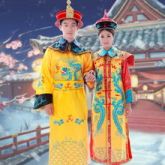
China is the birthplace of dragon culture. This has been shown by relics of the Neolithic Age discovered in the Yellow River, Yangtze River and Liaohe River Basins.
▲Origin of Dragon Culture
Dragon was one of the totem worship images in remote times when people liked to use the images of creatures or plants which they held in awe as symbols of their tribes. They believed that totem worship could bring them protection and good luck. Chinese dragon was used as a totem of the emperor, symbolizing the power of the emperor. Only emperor can use the things which were decorated with dragon pattern.
Chinese dragon is of magic power. It can change the length of its body as it wishes; it can either fly or swim. It is believed to control the weather, being responsible for causing snowstorm, lightning, and tornadoes.
People in ancient China often offered sacrifices to Dragon for favorable weather and good harvest. In the Warring States Period (475-221BC), dragon was often drawn in the painting on silk. Dragons often appear in Chinese idioms and tales. (323 words).
1. What’s the difference between western dragon and Chinese dragon?2. Why do Chinese say they are offspring of the dragon?
3. What’s Chinese dragon like? Describe it.
4. In ancient times, were common people allowed to wear clothes with dragons decorated? If not, why?
【推荐3】Solothurn is a picturesque town in the northwest of Switzerland known primarily for its closest relation with the number eleven. It seems like everything in this place was designed around this magical number, from the fact that there are precisely eleven churches, as well as eleven historical fountains, eleven museums and eleven towers, to the unusual clock in the town square that features an elevenhour dial and the number twelve missing.
Although nearly everyone in Solothurn knows about the town's obsession with the number eleven, the origin of that is covered in mystery. The first mention of eleven in Solothurn's history dates back to 1252, when eleven members were first elected for the town's council. Another great example of Solothurn's obsession with the number eleven is the magnificent Cathedral of St. Ursus. Designed by Italian architect Gaetano Matteo Pisoni, it was built in eleven years. It features three sets of steps, each numbering eleven rows, eleven doors, eleven bells and eleven altars, one of which is made out of eleven different types of marble. Interestingly, the altars can be viewed at the same time from only one place in the cathedral, the eleventh black stone in the long central part.
The people of Solothurn also show an intense interest in the number eleven in their daily life. There are special celebrations held on eleventh birthdays, and there are local products and businesses that include the special number. There is “ÖufiBier” (Beer eleven), “eleveni Schokolade” (elevenChocolate), and even “öufiyoga” (eleven o'clock yoga). The mysterious relationship between Solothurn and the number has become one of the town's primary tourist attractions, and there is even a themed tour about the number eleven.
1. What is mainly discussed about Solothurn in Paragraph 1?| A.Its unique designs. | B.Its cultural origin. |
| C.Its natural attractions. | D.Its connection with nature. |
| A.The number eleven. | B.The city of Solothurn. |
| C.Solothurn's love for eleven. | D.The history of Switzerland. |
| A.Its steps contain 33 rows in all. | B.Its doors are made out of marble. |
| C.It has eleven bells on each step. | D.It has eleven altars in the center. |
| A.They attach great importance to tourism. | B.They bring number eleven to daily life. |
| C.They lead a busy but comfortable life. | D.They are expert at designing products. |
【推荐1】Invented in the Tang Dynasty and widely adopted after the Song Dynasty in Fujian, the watertight-bulkhead (水密舱壁) technology permits the construction of ocean-going ships with watertight compartments (隔层). If one or two cabins are accidentally damaged at sea, water will not flood the other cabins and the ships will remain afloat.
The experience and working methods of watertight-bulkhead technology are transmitted orally from master to apprentices. However, the need for Chinese junks (中国式帆船) has decreased sharply as wooden ships have been replaced by steel-hulled ships, and today only three masters can claim full command of this technology. Associated building costs have also increased owing to a shortage in raw materials. Therefore, the inheritance (继承) of this heritage is decreasing, and inheritors are forced to seek alternative employment.
Zhang Guohui, a 77-year-old inheritor of the watertight-bulkhead techniques used to make Chinese junks, has been making ships for more than six decades. Coming from a poor family in a fishing town in East China’s Fujian Province, Zhang started to make a living at the age of 16 fishing on the open seas, which is where he developed a keen interest in constructing boats. As a fast learner, Zhang was later sent to shipyards in the cities of Quanzhou and Xiamen in Fujian Province, where he received training and became a master of traditional Chinese junks and gained fame because of his extremely skilled craftsmanship in the construction of these junks.
In fear that the traditional skills would die someday, Zhang started to restore old ships and make model junks for the museum with his 20 years of shipbuilding skills. “The restored ancient ships are the historical witnesses of Quanzhou as a maritime center of the East and Southeast Asia trade network,” said Zhang, adding that he finds the work meaningful since younger generations can learn from exhibitions of ancient ships that their ancestors had advanced shipbuilding technology at an early stage of development. “As long as I’m alive, I’ll keep passing on the heritage,” he said.
1. What function is expected of the watertight-bulkhead technology?| A.To prevent ships from sinking. | B.To reduce the weight of ships. |
| C.To allow ships to sail faster. | D.To help ships resist strong winds. |
| A.To prove the significance of steel-hulled ships.” |
| B.To stress the complex process of building wooden ships. |
| C.To present people’s efforts to pass down cultural heritages. |
| D.To show difficulties of inheriting watertight-bulkhead technology. |
| A.He supports his family by fishing. |
| B.He was born with a talent for shipbuilding. |
| C.He has devoted himself to constructing boats. |
| D.He has won many awards for restoring ancient ships. |
| A.Traditional culture should be innovated with the times. |
| B.The ancient ship trade originated from Quanzhou in China. |
| C.It is necessary for modern students to learn shipbuilding skills. |
| D.It is worth passing on traditional skills from generation to generation. |
Good morning... I hope you all are doing well in your studies and if there is a problem related to your studies, please feel free to come to my office. Today, I and all the teachers decided to gather all the children for the speech on World Heritage Day. Since the day is around the corner, I wanted to give knowledge to my children on this subject. As a Principal of this school, I try not only to make my children perform well in studies, but also to enlighten them on subjects which are very much concerned about mankind.
World Heritage has been described as the common wealth of mankind. This day is a great reminder of our rich cultural past and it is our responsibility that we protect our heritage not only for ourselves but for future generations. Undoubtedly, heritage sites should be preserved and protected. They are invaluable wealth for mankind. The date of the holding of World Heritage Day is April 18 and it was first started in the year 1982.
I am speaking from my personal experience and I am sure every one of you must have noticed at some point. Regarding the fact that many people have developed irresponsible (negligent) attitude towards our national heritage. This is the reason that heritage buildings are often found damaged. However, it is due to the continuous repair work of such sites by the government that our nation is still able to keep its beauty, if not in its entirety, but at least to an extent it attracts millions of tourists a year.
World Heritage Day is actually a day for every concerned citizen of a country to feel proud of the great cultural property of its nation. At last, I want to say in many ways, we can contribute towards the maintenance (维持) of world heritage sites so that their beauty does not minimize and they remain the center of attraction for people all over the world.
Please consider what you can do to maintain the beauty of the world heritage. Let’s do our best!
1. Why does the speaker make this speech?2. What does the World Heritage Day remind us according to the speaker?
3. What can you do to contribute towards the maintenance of world heritage sites?
【推荐3】The Lake of Heaven
Changbaishan is in Jilin Province, Northeast China. Much of this beautiful, mountainous area is thick forest. Changbaishan is China’s largest nature reserve and it is kept in its natural state for the people of China and visitors from all over the world to enjoy. The land varies in height from 700 meters above sea level to over 2,000 meters and is home to a great diversity of rare plants and animals, Among the rare animals are cranes, black bears, leopards and tigers. Many people come to Changbaishan to study its unique plants and animals. Others come to walk in the mountains, to see the spectacular waterfalls or to bathe in the hot water pools. However, the attraction that arouses the greatest appreciation in the reserve is Tianchi or the Lake of Heaven.
Tianchi is a deep lake that has formed in the crater of a dead volcano on top of the mountain. The lake is 2,194 meters above sea level, and more than 200 meters deep. In winter the surface freezes over. It takes about an hour to climb from the end of the road to the top of the mountain. When you arrive you are rewarded not only with the sight of its clear waters, but also by the view of the other sixteen mountain peaks that surround Tianchi.
There are many stories told about Tianchi. The most well-known concerns three young women from heaven. They were bathing in Tianchi when a bird flew above them and dropped a small fruit onto the dress of the youngest girl. When she picked up the fruit to smell it, it flew into her mouth. Having swallowed the fruit, the girl became pregnant and later gave birth to a handsome boy. It is said that this boy, who had a great gift for languages and persuasion, is the father of the Manchu people.
If you are lucky enough to visit the Lake of Heaven with your loved one, don’t forget to drop a coin into the clear blue water to guarantee your love will be as deep and lasting as the lake itself.
1. Which of the following has not been mentioned as a feature of Changbaishan?| A.It is home to a great variety of rare plants and animals. |
| B.It is cold and has always been covered with snow. |
| C.It has beautiful waterfall and water pools. |
| D.It is very high above sea level. |
| A.The forest. | B.The waterfall. |
| C.The sea. | D.Tianchi. |
| A.It is not very deep. |
| B.It is covered with ice in winter. |
| C.It is surrounded by small lakes. |
| D.It is at the foot of Changbaishan. |
| A.boring | B.inspiring | C.interesting | D.confusing |



